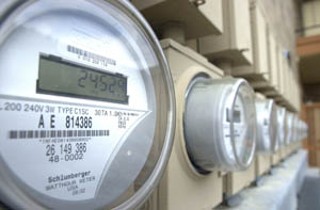Making the Energy Grid Smarter
New nonprofit pushes energy providers for efficiency via high tech
By Daniel Mottola, Fri., Feb. 17, 2006

In the last 50 years, technology has monumentally impacted the way we store and share information, as well as the way we communicate. A new nonprofit organization, the Center for the Commercialization of Electric Technology – a unique conglomeration made up of investor-owned utility companies, a high tech firm, and six public universities – believes the electric power grid is lacking the benefit of today's high tech innovations and has set out to apply the latest in communication and information technology to the grid in the form of a "smart energy network," which they say will make the grid more reliable and more efficient, and even diminish the need for new, polluting power plants, while expanding renewable power use through energy storage. But the new effort isn't without its detractors, who criticize its use of automated meters and say it appears to be a special-interest nonprofit, putting industry enrichment before real proven attempts toward efficiency, at the customers' expense.
Austin engineer Bob King is one of the CCET's intellectual fathers. He's also one of the pioneers of the state's renewable-energy industry and a longtime fixture at the state Capitol, having worked on both sides of the aisle in energy and energy-efficiency policy. The CCET's organizational structure is now being sculpted in the offices of Good Company Associates, King's energy and environmental resources consulting and lobbying firm. King called the CCET "the perfect convergence of the high-tech industry and the energy efficient mindset of the community," and described its plans to use "smart" communicating electric meters and appliances as the "hybridization of the building environment." A series of laws he helped bring about has paved the way for a statewide transition to next-generation electric meters and will encourage utilities to increase their historically low investments in research and development. He said CCET's office will be located in Austin and is intended to grow to a $50-million-to-$100-million-per-year outfit within three years.
Milton Holloway, chief operating officer of the CCET, said the organization will stimulate economic growth through the "successful implementation of technology, the location of device manufacturing plants, the lowering of utility rates," and with increased spending on research by firms and universities. He said CCET's projects include everything from developing outage detection and monitoring systems, capable of predicting grid failures; to working with energy storage techniques such as batteries, compressed air, and hydroelectrics; to establishing a standardized structure or architecture to allow new technology to interconnect and communicate on a large scale. With communication capabilities added to power lines, Holloway said, consumers would likely realize the ancillary benefit of added competition in the high-speed internet service business.
Among the CCET's goals is to level statewide peak energy consumption or move usage away from high-demand times. King explained that utilities often must activate old, dirtier power plants (think Austin's Holly plant) to supply the needed energy at peak times, like on an August afternoon for example. He often compared the electric grid to a cellular phone network, pointing out that there's now no difference between peak and off-peak rates for consumer energy pricing, even though supplying energy at peak demand can cost utilities up to 100 times more. He also pointed out that utility customers must wait for a strolling meter reader to visit once a month before learning how much energy they've used, while cell phone customers can call at any time to find out how many minutes they've spent. The technology the CCET hopes to introduce to the electric grid could provide utility customers with real-time information about their consumption. Utilities would be able to offer price incentives and demand-based pricing, much like cellular carriers, to encourage customers to move their energy consumption away from peak times. King says this creates efficiency and could delay the necessity for new power plants, perhaps up to 20 years. Software packages could even be made available to manage a household's energy usage, directing smart appliances – currently being developed – to operate at optimal times.
The six affiliated universities, organized into the Texas Consortium for Electric Energy, are key players in the CCET. Dr. Mladen Kezunovic of Texas A&M's electrical engineering program explained that while he and his students will likely focus on improving the reliability of the state electric grid, the most important – perhaps even historical – aspect of the CCET is that it marks the first time the state's major utilities, not to mention its major universities, have come together to focus on advanced technology, "with the ultimate goal of improving electric delivery in the state of Texas." Kezunovic said each entity "realized that they cannot do it on their own and started to get together," and in turn, "everybody will benefit." He said the universities first came together with state legislators, industry, and the U.S. Department of Energy in College Station in November of 2004 for the first Texas Electric Energy Forum. Kezunovic said the state's $200 million emerging technology fund, which he hopes will provide programs like his with matching research funds, was created based in part on that first forum meeting, and that organizations such as the DOE and the nonprofit Electric Power Research Institute (which partnered with the city on its Plug-in Hybrid vehicle campaign) are now working to encourage similar cooperative efforts nationwide. At least six other states have entities that resemble the CCET, Kezunovic says, and the CCET, formally incorporated in September 2005, "puts Texas in line with other states that are progressive in energy and electricity."
Carol Biedrzycki, executive director of Texas Ratepayers' Organization to Save Energy, a local nonprofit representing residential and low-income consumers and promoting energy efficiency and fair utility programs, said that while the advanced, automated electric meters on which the CCET programs would depend have their advantages, the transition would be very costly and comes with some policy gray areas. For instance, Biedrzycki said by using the meters to send customers price signals about peak demand, you're "telling people they'll pay the most for energy when they need it the most … hurting the people on the system who are most vulnerable." And because power can be cut remotely, without a site visit, that raises concerns over the safety of elderly or disabled residents, she said. "The focus should be on making permanent changes to reduce the amount of energy used," she said, "while advanced metering simply shifts the time energy is used." She'd rather see permanent reductions through such policies as stricter, more efficiency-oriented building codes, and the use of high efficiency insulation, windows, and appliances.
Got something to say on the subject? Send a letter to the editor.








